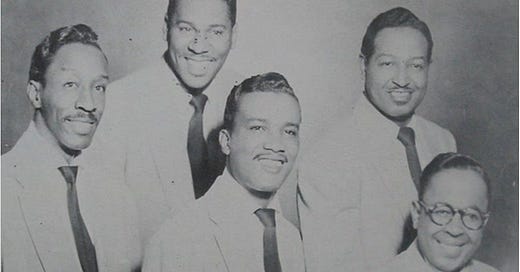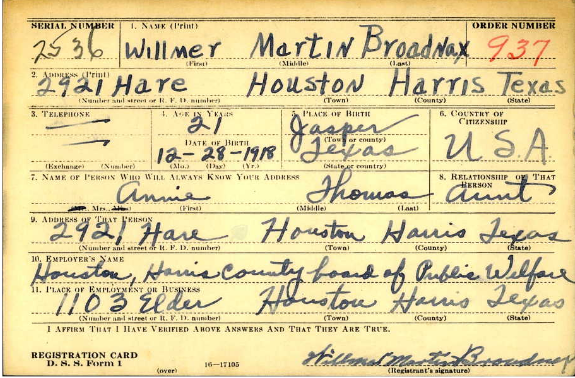Was Houston male gospel quartet star Willmer Broadnax born a woman?
In death, "Little Ax" has become an LGBTQ hero

Gospel fans and fellow performers wondered about quartet singer Willmer Broadnax, nicknamed “Little Ax,” whose brother William was called “Big Ax” because at 5’ 7” he towered over Willmer. When he hit those impossibly high notes as a member of the Spirit of Memphis and Fairfield Four quartets, it wasn’t falsetto. That was his natural voice.
In the liner notes to Shanachie’s 2000 compilation Kings of the Gospel Highway, music historian Anthony Heilbut confirmed suspicions of Little Ax’s gender when he wrote that after Broadnax was stabbed to death in 1992, the autopsy revealed that he had female genitalia. Little Ax had passed as a man for 50 years! “But, of course,” sang gospel’s gossip choir. Broadnax looked and sang like a woman in a man’s suit.
But although the trans revelation explained a lot, it was presented without any evidence to back it up.
In recent years Willmer Broadnax has become a hero in the online LBGTQ community, with the story about a woman presenting as male because it was easier to get popular in a male gospel quartet than a female one (not true in that time of the Caravans, Ward Singers, the Original Gospel Harmonettes and many more. ) told in such sites as TransGriot, lgbt.wiki.org, TransGuys and Gender Variance Who’s Who. But what about the U.S. Census of 1920, 1930 and 1940 that list Willmer Broadnax as a male?
Trans historian Zagria Cowan speculates that Willmer, the gospel singer, could actually be his younger sister (name misspelled “Armatha” in the 1930 Census) who assumed his identity. This theory is also taken up by the Untitled Black Lesbian Elder Project, a blog for a full-length documentary in the works, which wonders why the last we see of “Armatha” is 1930.
But Amethia Nadine Broadnax Young, six years younger than brother Willmer, lived until 2003, when she died in Philadelphia at age 81. All public information points to Willmer Broadnax being born a male and dying a male. Why would a woman passing as a man fill out a draft card registration in 1940?
The Philadelphia police department replied “no record found” when I requested a copy of the autopsy, but certainly the judge and attorneys in the 1993 trial of Lavinia Richardson, 42, who stabbed boyfriend Broadnax to death, had access to such evidence. Here’s the newspaper report:
Amethia also lived at 54th and Euclid at the time of the killing, so Willmer most likely had been staying with his sister.
I tried to reach Tony Heilbut, whose The Gospel Sound: Good News and Bad Times (1971) is the Bible of the genre’s history, to find out on what he based his autopsy revelation, but the email address I’ve had for years is no longer active. My guess is that someone told him, or that the story was whispered legend. In conversations and by his fascinating, yet credibility-stretching 2012 memoir/history The Fan Who Knew Too Much, Heilbut is out to out many of the key figures in gospel. Nobody is closer than Heilbut to the characters of gospel’s golden age. But innuendo is not fact.
Irrefutable is that Willmer “Little Ax” Broadnax was one of the great heavenly shouters of his time. Born in Jasper, Texas on Dec. 28, 1916 or 1918, and raised in Houston, Willmer came of age during the 1950’s when Don Robey’s Peacock label made “hard gospel” a thing with records by Archie Brownlee’s Five Blind Boys of Mississippi and the Sensational Nightingales of Julius Cheeks. Gospel concerts were billed as battles, with singers trying to out-shriek, out-growl, out-writhe each other for the title, and Little Ax cut down most contenders. To see and hear such vocal power come from such a small package drove audiences crazy. After Brownlee died in 1960, Broadnax replaced his replacement Roscoe Robinson, who went solo after a dispute with Robey.
In 1963, he reformed his 1940’s quartet, putting his name in front: Little Ax and the Golden Echoes, but their four singles on Peacock didn’t do much. Broadnax did most of his singing in church after that and was virtually unknown at the time of his death.
But after Heilbut’s disclosure, backed by others who claimed to have seen the autopsy, there’s renewed interest in the pint-sized powerhouse. “Wilmer 'Little Axe' Broadnax is another fascinating story from our Black trans history and another concrete example of Black trans people being an integral kente cloth part of our Black community,” writes the TransGriot blog. It’s a good, uplifting story; do we really need proof? Isn’t that what religion is based on?
People believe what they want to believe. That’s a fact of life. But evidence points to that churchwrecker Willmer Broadnax being born a male.





